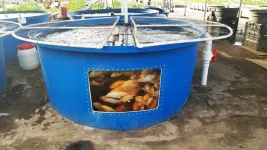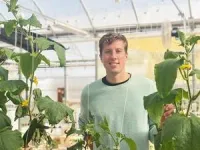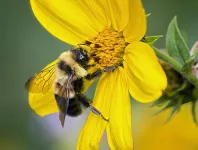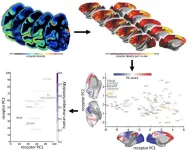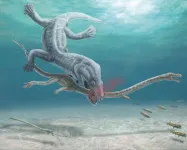(Press-News.org) Digesting fish waste can allow circular fish and vegetable farms (aquaponics) to produce biogas that can be fed back into the energy system of these farms. This also generates excellent nutrition for plants, according to new research from the University of Gothenburg.
There is increasing growth in circular, land-based, combined fish and vegetable farms- often referred to as aquaponics. Aquaponics makes use of nutrient-rich water produced by fish (aquaculture) which can be used to fertilise plants (hydroponics) in a closed, soil-less system with the help of bacteria that grow naturally within the systems. These food production models imitates the fertilisation that occurs in river and lake ecosystems. The solid waste of fish has been a by-product with no particular value until now. But a research project at the University of Gothenburg has used the waste to make biogas that can contribute to meeting the energy needs of the aquaponic farms. This is described in Victor Lobanov’s dissertation.
Waste is broken down in an anaerobic environment
“By breaking down fish faecal matter in an anaerobic environment – known as digestion – we can obtain a concentrated gas mixture of 70 percent methane that can be used as fuel. This can make aquaponics a source of energy,” says Victor Lobanov, doctoral student of marine biology at the University of Gothenburg.
The study also shows that the nutrients released in the digestion of waste are more easily available for plants compared to synthetic nutrition solutions.
“Fish waste contains a lot of nutrients. These should also be usable in aquaponics to enable even more sustainable food production than today,” says Victor Lobanov.
Another benefit is that carbon dioxide is produced when the biogas is used as fuel, which is a necessary supplement when plants are grown in an enclosed space, like a greenhouse.
Pilot starts this summer
For now, the digestion process has only been tested in a lab environment, but a pilot in a commercial aquaponics facility is starting this summer. It will give researchers insights into how well the method can handle perturbations to the system and what needs to be done to create a more robust digestion pipeline. Victor Lobanov’s goal is to create modular digestion systems that can be Integrated into existing aquaculture and aquaponic facilities.
There is significant interest from the industry, and the technology could also be used in other animal husbandry applications such as piggeries. The sludge left over after digestion is still extremely nutritious and can be used for traditional fertilisation of fields. In this new process, the residual sludge leftover and, crucually, its eutrophication potential, is reduced.
“In many countries, the quantity of fertiliser produced in livestock farming is a problem. It can only be spread on fields during certain times of the year and removing wastes from the farm is associated with extra costs during pumping and transportation. Digestion of the fish solids reduces the quantity of waste produced by farms while additionally producing energy and a great fertiliser for hydroponics,” says Victor Lobanov.
END
Fish farms can become biogas producers
2023-06-20
ELSE PRESS RELEASES FROM THIS DATE:
Machine learning helps researchers identify hit songs with 97% accuracy
2023-06-20
Every day, tens of thousands of songs are released. This constant stream of options makes it difficult for streaming services and radio stations to choose which songs to add to playlists. To find the ones that will resonate with a large audience, these services have used human listeners and artificial intelligence. This approach, however, lingering at a 50% accuracy rate, does not reliably predict if songs will become hits.
Now, researchers in the US have used a comprehensive machine learning technique applied to brain responses and were able to predict ...
Completing genome of rusty patched bumble bee may offer new approach to saving endangered bee
2023-06-20
LOGAN, Utah, June 20, 2023 — A detailed, high-resolution map of the rusty patched bumble bee’s genome has been released by U.S. Department of Agriculture (USDA) Agricultural Research Service (ARS) and U.S. Fish and Wildlife Service (USFWS) scientists, offering new possible approaches for bringing the native pollinator back from the danger of extinction.
Putting together the rusty patched bumble bee genome is part of the Beenome 100 project, a first-of-its-kind effort to create a library of high-quality, ...
Face of Anglo-Saxon teen VIP revealed with new evidence about her life
2023-06-20
The face of a 16-year-old woman buried near Cambridge (UK) in the 7th century with an incredibly rare gold and garnet cross (the ‘Trumpington Cross’) has been reconstructed following analysis of her skull. The striking image is going on public display for the first time on 21st June, with new scientific evidence showing that she moved to England from Central Europe as a young girl, leading to an intriguing change in her diet.
The image and artefacts from the mysterious woman’s ...
Weak policies and political ideologies risk jeopardizing plans to tackle health and climate change, says Cambridge expert
2023-06-20
Weak policies and political ideologies risk jeopardising plans to tackle health and climate change, says Cambridge expert
Efforts to tackle major issues facing the UK, including the nation’s health and climate change, are being hampered because politicians often ignore the existing evidence when setting policies, according to Dame Theresa Marteau, a public health expert at the University of Cambridge.
Writing in the journal Science and Public Policy, Professor Marteau argues that this ‘evidence-neglect’ is a result of incentive structures that encourage politicians to set ambitious policy goals while simultaneously disincentivising ...
Low-dose aspirin use associated with 20% increased anemia risk in older adults
2023-06-19
1. Low-dose aspirin use associated with 20% increased anemia risk in older adults
Abstract: https://www.acpjournals.org/doi/10.7326/M23-0675
URL goes live when the embargo lifts
An analysis of the ASPREE (ASPirin in Reducing Events in the Elderly) trial found that the use of low-dose aspirin was associated with a 20 percent increased incidence of anemia and decline in ferritin, or blood iron levels, in otherwise healthy older adults. These findings suggest that periodic monitoring of hemoglobin should be considered in older patients taking aspirin. The analysis is published in Annals ...
Chinese paleogeneticist FU Qiaomei awarded UNESCO–AI Fozan International Prize for the Promotion of Young Scientists
2023-06-19
FU Qiaomei, a paleogeneticist at the Chinese Academy of Sciences (CAS), received the UNESCO–AI Fozan International Prize for the Promotion of Young Scientists in Science, Technology, Engineering and Mathematics (STEM) on June 19 in Paris, France, for her “seminal work on the history of early humans in Eurasia, based on genetic lineage studies, which provides new insights on the early human history of Eurasia and perspectives on the evolution of human health.”
She was one of five young scientists from around the world to receive the prize, alongside researchers from Argentina, Cameroon, Egypt, and Serbia. The laureates were ...
Clean, sustainable fuels made ‘from thin air’ and plastic waste
2023-06-19
Researchers have demonstrated how carbon dioxide can be captured from industrial processes – or even directly from the air – and transformed into clean, sustainable fuels using just the energy from the Sun.
The researchers, from the University of Cambridge, developed a solar-powered reactor that converts captured CO2 and plastic waste into sustainable fuels and other valuable chemical products. In tests, CO2 was converted into syngas, a key building block for sustainable liquid fuels, and plastic bottles were converted into glycolic acid, which is widely used in the cosmetics industry.
Unlike earlier tests ...
Human Brain Project study offers insights into neuroreceptor organization
2023-06-19
A key challenge in neuroscience is to understand how the brain can adapt to a changing world, even with a relatively static anatomy. The way the brain’s areas are structurally and functionally related to each other – its connectivity – is a key component. In order to explain its dynamics and functions, we also need to add another piece to the puzzle: receptors. Now, a new mapping by Human Brain Project (HBP) researchers from the Forschungszentrum Jülich (Germany) and Heinrich-Heine-University Düsseldorf (Germany), in collaboration with scientists from the University of Bristol (UK), ...
These long-necked reptiles were decapitated by their predators, fossil evidence confirms
2023-06-19
In the age of dinosaurs, many marine reptiles had extremely long necks compared to reptiles today. While it was clearly a successful evolutionary strategy, paleontologists have long suspected that their long-necked bodies made them vulnerable to predators. Now, after almost 200 years of continued research, direct fossil evidence confirms this scenario for the first time in the most graphic way imaginable.
Researchers reporting in the journal Current Biology on June 19 studied the unusual necks of two Triassic ...
Brain receptor patterns separate sensory and cognitive networks, new study finds
2023-06-19
Receptor patterns define key organisational principles in the brain, scientists have discovered.
An international team of researchers, studying macaque brains, have mapped out neurotransmitter receptors, revealing a potential role in distinguishing internal thoughts and emotions from those generated by external influences.
The comprehensive dataset has been made publicly available, serving as a bridge linking different scales of neuroscience - from the microscopic to the whole brain.
Lead author Sean Froudist-Walsh, ...
